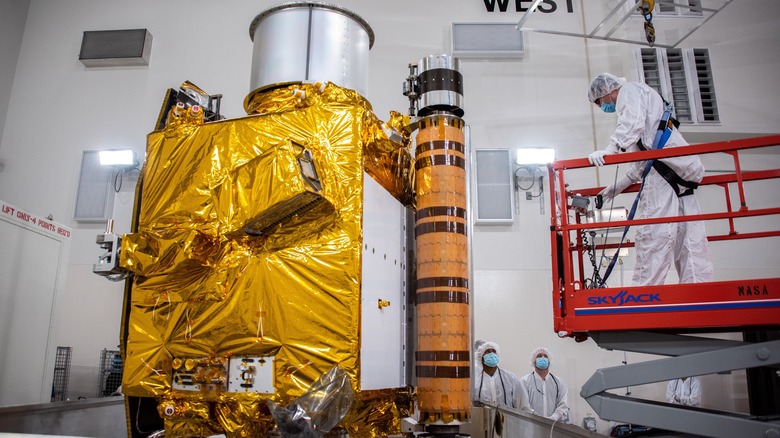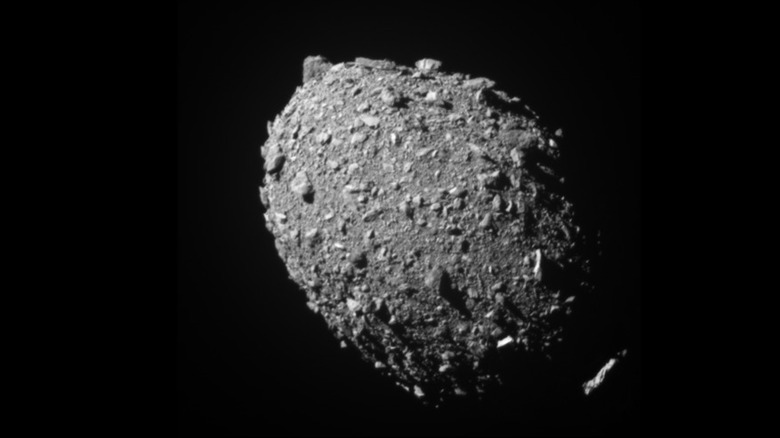Inside DART Spacecraft's Wild Final Voyage
So here's an idea: let's like, totally shoot a big bullet into space. We're talking really big, okay? Just make a big 'ole space gun and shoot a big 'ole space bullet — more of a "DART," let's call it — right at a big 'ole asteroid. It'll be like shooting cans off a log in the backyard with a BB gun, except the cans are a big space rock headed right towards Earth to destroy human civilization. Anyone remember the movie "Armageddon"? It's like that, but with less Bruce Willis, no Aerosmith theme song, and a whole lot more computer science. But in the end, you still get a big boom.
Well, believe it or not, this just happened on September 26, 2022. What sounds like an idea pitched by a 12-year-old to his dad at dinner time was actually planned, orchestrated, and carried out by some of the finest scientific minds we've got: the folks at NASA. As NASA's website says, their Double Asteroid Redirection Test (DART) sent a "box-shaped" spacecraft right into an itty-bitty, 160-meter-long (about 530 feet) asteroid moonlet named Dimorphos. Dimorphos — which, no, doesn't actually present any threat to Earth — orbits a larger, 780-meter-long (about 2,560 feet) asteroid called Didymos that itself orbits the sun like us (also via NASA).
Lest the reader think that NASA was just bullying a space rock by punting it with a big bullet, think again. This test was Earth's first ever historical demonstration of legitimate "planetary defense technology."
A successful test of Earth's planetary defenses
So before you go shouting, "We did it!" and chucking American flag baseball caps into the air: No, DART didn't obliterate little Dimorphos. The objective of the test, as NASA states, was merely to alter Dimorphos' orbit by about 1% — to shorten its time circling around the asteroid Didymos by about 10 minutes. This initial mission exists to gather data before implementing a larger, "full-scale test." This doesn't mean that the next time we're sending Will Smith and Jeff Goldblum into space to "download a virus into" the lead spacecraft of an alien invasion or something. But we're guessing there might be some bigger boom-booms that go boom.
DART officially struck Dimorphos on September 26, 7:14 p.m. EST. Like existence's longest-range sniper round, the projectile had been on course for 10 whole months. As NASA describes, DART was flying at 6.6 kilometers per second at the time of impact (about 4 miles per second) when Dimorphos was about 11 million kilometers away (6.8 million miles). Considering the distance and that every object involved was moving — Earth, Dimorphos, Didymos, DART — NASA's navigation systems deserve some intense credit.
DART even had a camera on board — its only instrument — so folks back at mission control and the public at large could watch the fun. Starting around the final five and half minutes, DART approaches Dimorphos, makes impact, and the screen cuts out.
One small step for man, one giant bullet for mankind
The truth is, before the present, there'd been no real way to stop an asteroid from smashing into Earth. And judging by mass media, this is certainly a preoccupation of ours — sites like SyFy and Space.com list their top "apocalypse by asteroid impact" films, which is practically its own sub-genre of sci-fi by now. It's true that there are about 25,000 "near-Earth" asteroids that pose a risk to Earth (via the CBC), but looking at extinction-level events like the impact that wiped out the dinosaurs, impacts are quite unlikely, indeed. Space is pretty dang spacious, after all.
Regarding the DART mission, NASA Administrator Bill Nelson stated, "At its core, DART represents an unprecedented success for planetary defense, but it is also a mission of unity with a real benefit for all humanity," and, "As NASA studies the cosmos and our home planet, we're also working to protect that home, and this international collaboration turned science fiction into science fact, demonstrating one way to protect Earth."
Thomas Zurbuchen, associate administrator for the Science Mission Directorate at NASA Headquarters in Washington, said, "Planetary Defense is a globally unifying effort that affects everyone living on Earth. Now we know we can aim a spacecraft with the precision needed to impact even a small body in space. Just a small change in its speed is all we need to make a significant difference in the path an asteroid travels."

